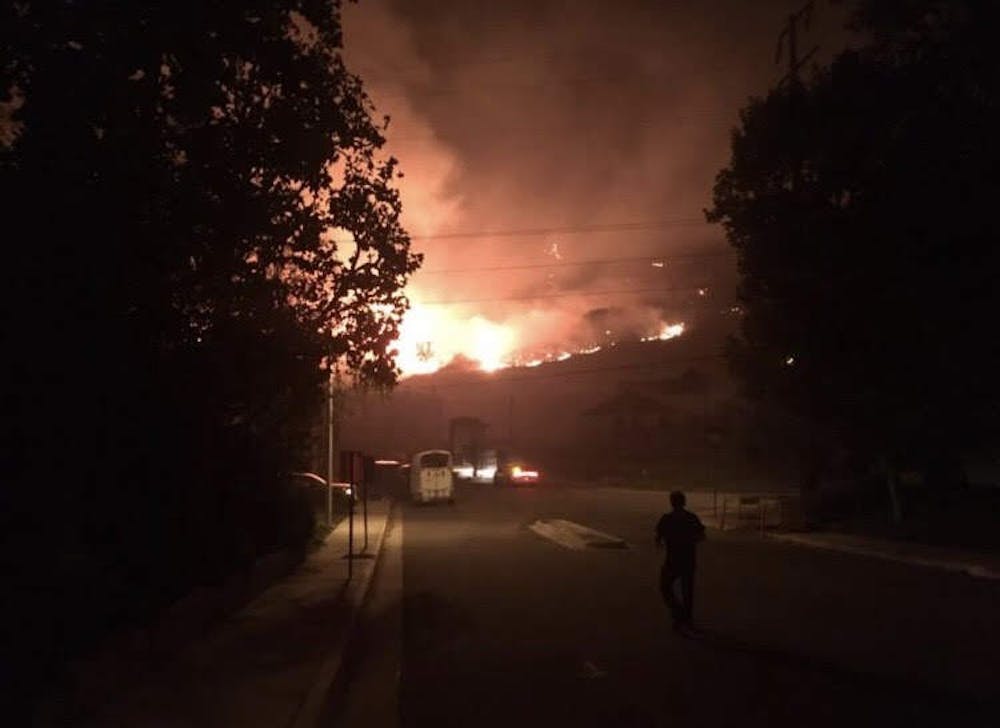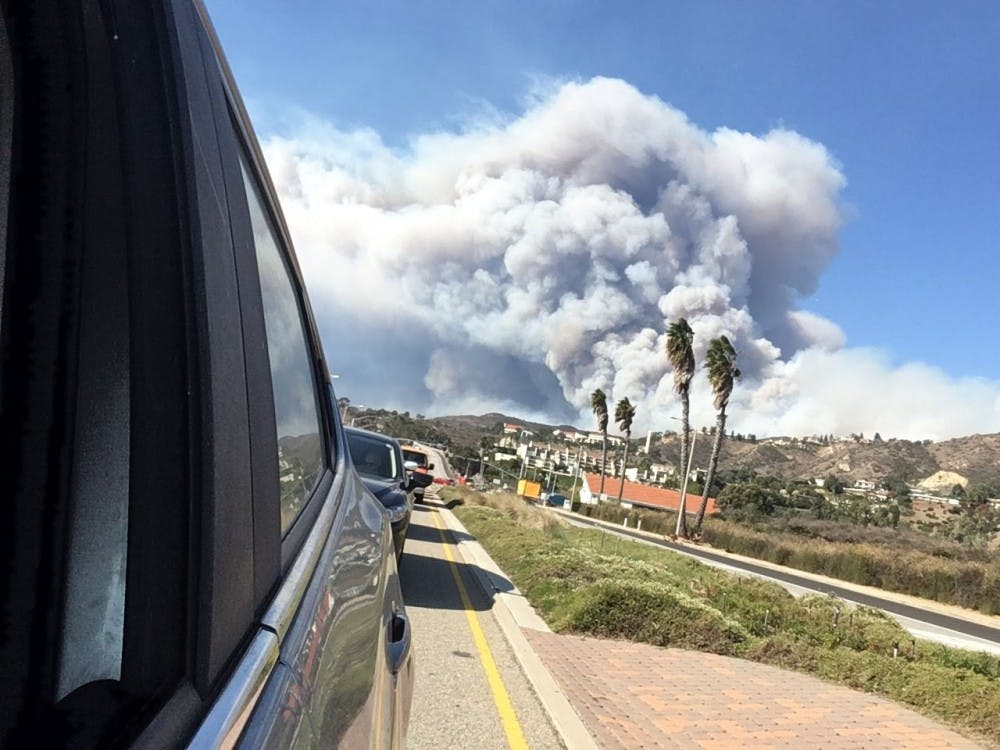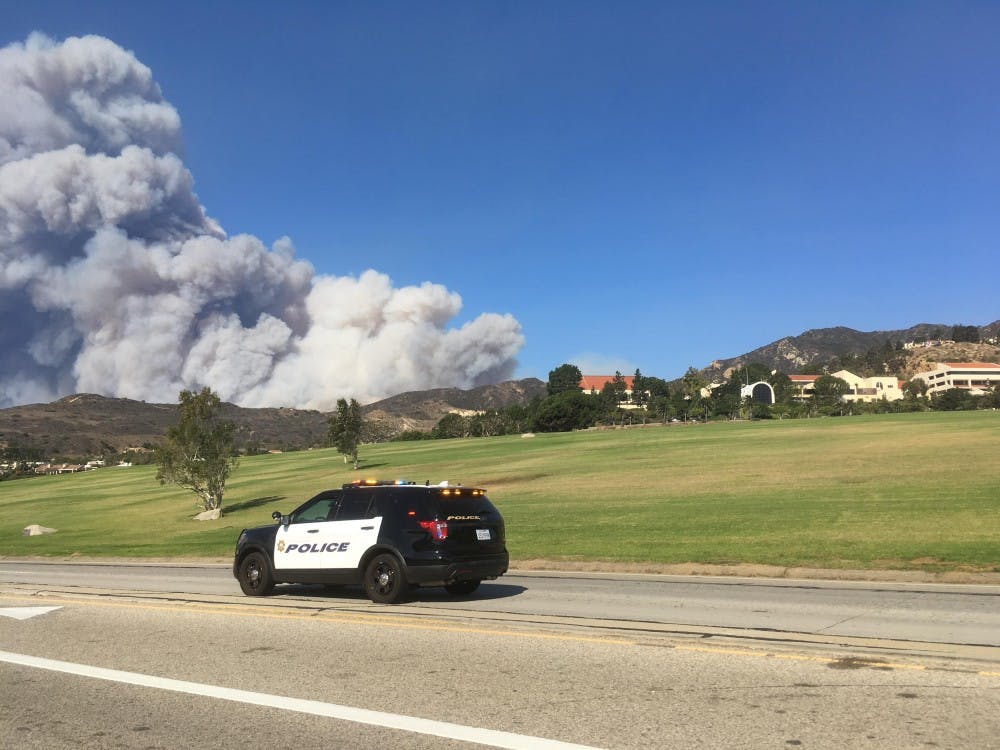Several students are dealing with the damaging effects of the Woolsey Fire in Southern California while going to school hundreds of miles away in Portland. The Woolsey Fire, which ignited on Thursday Nov. 8, is now 100 percent contained after burning 96,949 acres of land and killing three people.
Senior English major Kyle Sparrman found out that her family had to evacuate their home in Thousand Oaks, California three weeks ago when her dad called and asked which of her belongings they should bring with them.
“I told them to grab...two memory boxes that I’ve been keeping since I was eight-years-old,” Sparrman said. “I’ve just been developing them over time, and so those were probably the most important things to me.”

Flames from the Woolsey Fire approaches the end of the col-de-sac where Kyle Sparrman's house remains. Photo Courtesy of Kyle Sparrman
According to the UP website, 26.4 percent of the student body is from California, which is the second largest state represented on campus. In addition to the Woolsey Fire, the Camp Fire in Northern California was the deadliest in California’s history, killing at least 85 people and citing 249 missing persons. After 17 days of fighting the fire that burned through 153,000 acres and destroyed over 14,000 residences, Cal Fire announced on Sunday Nov. 25 that the Camp Fire was finally contained.
Sparrman first heard about the Woolsey Fire in the afternoon of Thursday Nov. 8, and stayed awake all of Thursday night until 7 a.m. on Friday morning to watch the news and make sure that her family was safe. She missed classes on Friday to process it all.
Sparrman said her family was able to evacuate their home before the cell tower in their neighborhood burned down, so she was able to remain in contact with them. Along with some sentimental items, Sparrman’s family took their pets, water, passports and other important documents before driving to Sparrman’s godparent’s house in Burbank where they would be safe from the fires.
Sparrman’s house is still standing, but other houses less than a quarter mile away burned down. At the time, she said it was hard going to school hundreds of miles away while her family was evacuated.

This is the park in freshman Katherine Tolcher's neighborhood that caught fire. Photo Courtesy of Katherine Tolcher
“I feel really disoriented,” Sparrman said at the time. “I feel like you can’t help but feel helpless just because you know that there’s nothing you can do.”
Two weeks ago, the air quality in California ranked among the “the dirtiest in the world” and exceeded air pollution levels of cities in China and India, according to the New York Times. The smoke from the Camp Fire travelled 200 miles south to the San Francisco Bay Area where schools and colleges had to shut down due to the dangerous air quality. Many schools and universities in the surrounding Malibu areas also had to shut down and did not resume classes until after Thanksgiving weekend.
Junior economics and business major Lauren Kerr learned about the fires when she got a call from her older brother, a senior at Pepperdine University, while he was stuck in five-hour traffic on the Pacific Coast Highway after evacuating his off-campus house on Friday Nov. 9. His landlord informed him later that his house had burned down.

Junior Lauren Kerr's older brother took a picture of the smoke while he was stuck in traffic on the Pacific Coast Highway after evacuating his home at Pepperdine University. Photo Courtesy of Steve Kerr
Pepperdine evacuated campus on Saturday Nov. 10 and held classes remotely online until after Thanksgiving break. Kerr’s brother stayed with his parents in Saratoga, California while classes were held remotely.
Kerr’s brother missed class that Thursday Nov. 8 because of the Borderline Shooting that happened in Thousand Oaks the night before, leaving 12 dead. One of his good friends was at The Borderline Bar & Grill that night, although she was able to escape the scene safely. He heard about the fires just two hours after the names of the shooting victims were released.
“Everyone was already holding their breath and they didn’t think it could get any worse, and then it was just another thing,” Kerr said.
On Thursday night, other houses six miles away were being evacuated. Kerr’s brother kept his ringer on and turned up the volume on his phone so that he would wake up in case he got an evacuation notice in the middle of the night. He left Friday morning before receiving the mandatory evacuation notice and stayed with a friend in Santa Monica Friday night.

Junior Lauren Kerr's older brother took a picture of the smoke while he was stuck in traffic on the Pacific Coast Highway after evacuating his home at Pepperdine University. Photo Courtesy of Steve Kerr
“He just said it was weird having nothing and also he just has so much more empathy now for these things...especially after the shooting,” Kerr said. “It was crazy timing where it kinda all puts it in perspective like this can happen to anyone at any time.”
When freshman Katherine Tolcher first heard about the Woolsey Fire, she didn’t think it was going to be that bad because fires are a common occurrence where she’s from in Westlake Village, California. But when the park in her neighborhood suddenly caught fire, she began to worry.
“In that moment, I was kinda freaking out,” Tolcher said. “I was like ‘oh my gosh my house might burn down’ like when I come home for Thanksgiving break I might not have a house.”
After the shooting in Thousand Oaks and the news of the fires, Tolcher was watching the news constantly. She said she had a hard time paying attention in class because she was always reading the news to see if her family was safe. Luckily, Tolcher’s house survived the fire and her parents were able to return home safely two weeks ago.
“I’m just excited to go home, because after a time like this, after the shooting and then the fires, I just wanted to be home so bad and to be with everyone and be with my family and be with my friends,” Tolcher said.

A house stands in front of the flames burning on the hills while smoke begins to engulf Katherine Tolcher's neighborhood. Photo Courtesy of Katherine Tolcher
Sparrman said she saw on the news that a lot of the resources in Southern California were being allocated to higher income areas. Even celebrities like the Kardashians and Kanye West hired private firefighters to protect their homes in Calabasas. The media coverage has also paid a lot of attention to celebrities like Liam Hemsworth and Miley Cyrus, who lost their Malibu home to the fire last week.
Sparrman said that no matter who you are, losing a house is devastating, but celebrities and people with higher incomes have the money and resources to rebuild their lives.
“I’m so sorry, that’s awful,” Sparrman said. “But you have like three other houses. We only have one and some people lost everything.”
Brigid Lowney is the living editor for The Beacon. She can be reached at lowney19@up.edu.








